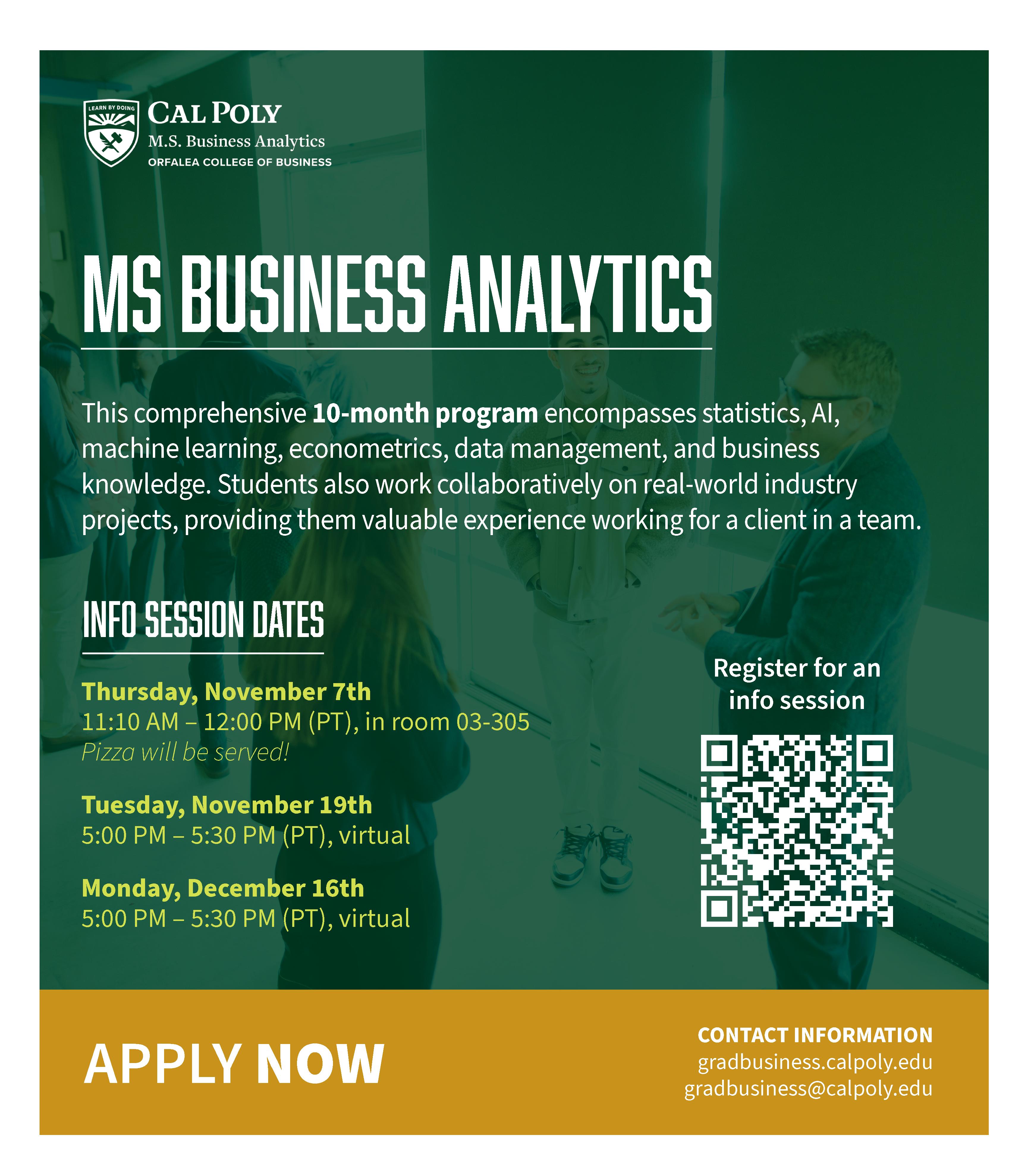MUSTANG NEWS
LEADERSHIP
Amelia Wu Editor in Chief

Amelia Wu Editor in Chief
NEWS
Caroline Ohlandt Editor
Katy Clark Assistant Editor
Nick Forselles
Abby Gorman
Leila Touati
Kaylin O’Connell
Bella Cox
Livia Angelini
Ava Tourgeman
Alex Kohm
Aditi Sriram
Riya Parekh
OPINION
Landon Block Editor
Erin Yarwood
Kaylie Wang
Ash Pickett
Brie Thompson
John Washington
Larena Tannert
Ani Nazarian
SPORTS
Sergio Romero Editor
Anthony Molleson Video
Nick Bandanza
Mark Robinson
Matthew Muren
Jonathan Sze
Joslen Jimenez
Ava Keshtkar
Andrew Aguiniga
Oliver Marburg
Coulter Langmaid
Lano Somotun
Andrea Aruino
Amanda Avila
Nadeen Maniord
Joe Forrestdavis
Ryan Giacomini
Ty Soria
Charlie Wiltsee
Dylan Allen
Jai Gulati
Jack Bynum
Warren Notrica
Rocco Brichler
DESIGN
Brandon Schwartz Creative Director
Aviv Kesar
Elizabeth Ridley
Kennedy Ray
Julia Hazemoto
Jolina Chen
Audrey Walch
Isa Cordovez
ARTS & STUDENT LIFE
Syd Spencer Editor
Kaylie Wang
Matthew Ho Managing Editor
Brandon Schwartz Creative Director
Maya Ziv
Rebecca Von Tersch
Sofia Livia
Katherine Lu
Vinithra Seshan
Kimber Draughon
Megan Tang
Makena Locsin
VIDEO
Cassandra Garcia Video Manager
RJ Pollock
Izzy Romero
Jessica Carp
Lauren Quijano
Emma Montalbano
PHOTO
Maura Shernisky Editor
Owen Roberts
Brandon Bomberger
Dijia Wang
Christina Thai
Eleanor Vickery
Soha Roy
Chloe Briote-Johnson
Andrea Aruino
Paige Teraji
SOCIAL MEDIA
Archana Pisupati Social Media
Manager
Avery Smigel
Ava Zamoff
Zoë Laureta
Gabrielle Ottaviano
Millie Marshall
Marlene Arroyo
Olivia Roman
Skylar Novak
Elizabeth Morton
DATA & INVESTIGATIONS
Elizabeth Wilson
Angel Corzo
Jeremy Garza
Alie Hall
Alex Tran
BILINGUAL
Kathyrn Hutchinson Editor
KCPR
LEADERSHIP
Kat Orozco Content Director
Emmy Burrus KCPR News Director
Mairi O’Toole Art Director
Amelia Nored Programming/ Music Director
Sophia Ermisch Marketing Director
Ben Shane Podcast Manager
KCPR NEWS
Emmy Burrus Director
Emma Montalbano Assistant Director
Cassandra Garcia
MNTV News Director
Leila Touati
Digital Director
Riley Sullivan
Sergio Romero
Izzy Romero
Fiona Hastings
Cayden Tan
Nadeen Maniord
Talie Krantz
Gabriella Lipsky
Ty Soria
Giselle Espinoza
Evelyn Santa Rosa
Delaney Ridder
Lauren Quijano
KCPR CONTENT
Kat Orozco Content Director
Angie Stevens Editorial Assistant
Ruby Citrin
Ella Giuliani
Asmahan Karam
Marley Logan
Olivia Nieporte
Gabrielle Ottaviano
Constantine Golematis
Bailee Isackson
ADVERTISING & PR
Sean Harmon Advertising Manager
Emma James
Alexander Poroy
Sydnie Bierma Special Sections Editor
Morgan Fitzgerald Marketing and
Public Relations Director
Amanda Wahl Advertising Design
Manager
Leah Coffey Marketing Assistant
ADVERTISING DESIGNERS
Ashley Ho
Christine Kim
Teia Kornienko
ADVERTISING ACCOUNT EXECUTIVES
Ruby Beye
Tara Davari
Kayla Harmon
Angie Ho
Kendall Jones
Julia Moore
Janalee Taguiam
Logan Teixeira
SPECIAL SECTIONS WRITERS
Sydnie Bierma Editor
Samantha Orradre
Kaitlyn Knopf
Kate Roarke
Madison White
Ashley Bates
Lillian Dolph


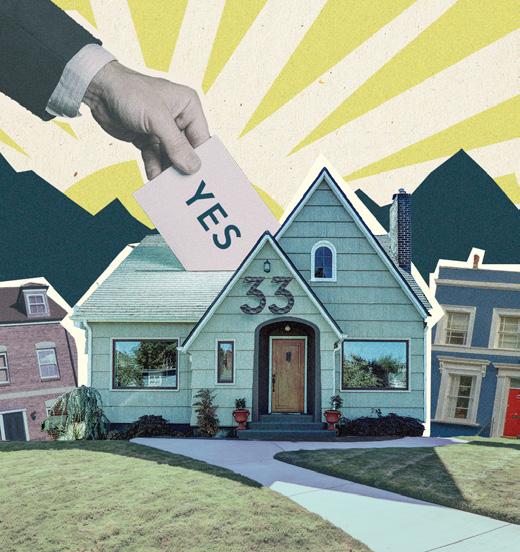


BY MUSTANG NEWS EDITORIAL BOARD
Mustang News’ coverage of the 2024 local elections seek to empower the Cal Poly student body and the greater San Luis Obispo community to engage in informed participation in our democracy. We hope to achieve this by producing comprehensive, digestive and interesting content.
Our mission in covering the election is to get our communities involved this election season by providing journalism that helps voters gain the information they need. We strive to understand issues from voters’ perspectives and compare their expectations with candidate promises.
We are committed to keeping our readers (you!) at the center of this conversation by checking in through surveys, social media and in-person events. Ultimately, we want to tell stories based on the questions you want answered, not just recount what politicians say.
In its coverage of the 2024 election, Mustang News will:
Demystify the voting process. We aim to demystify the voting process through clear, step-by-step explanations, ensuring every voter feels confident about where and when they can cast their ballots.
Cover events, forums and debates. Throughout the election cycle, we will be offering summaries, key takeaways and expert voices to help you understand where each candidate stands on important issues.
Detail candidate profiles. We will detail their backgrounds, policy positions and campaign promises. This will give you a clear picture of who is running and what they stand for.
Examine the influence of state and national politics. How do state and national political trends affect the local level? We hope to provide a bigger picture for you to see and understand the implications of your vote.
Answer reader questions. We are actively seeking and responding to questions from our readers. Your inquiries will help guide our coverage, ensuring we address what matters the most to you this election season.
We think it is important to be transparent about what guides our decisions on how and what issues we report on. We also want to prioritize efforts where we can most be helpful. For the Nov. 5 San Luis Obispo County races we will focus on the mayoral and city council races.
We will generally not report on state or national election races. However, we will link to resources on our website, social media channels and our newsletter, The Round-Up.
How do we decide newsworthiness?
Power. This means we prioritize coverage of races and policies that can influence decision-making processes or have a major impact on local governance. Whether it is a key mayoral race, city council election or pivotal policy change, we will examine how these events can shape the future of our local community. Interest. By staying attuned to the issues that generate discussion, concern and enthusiasm, we want to ensure our reporting remains relevant and engaging. This will include monitoring feedback from you and social media conversations. Our goal is to provide coverage that keeps you informed about the topics you care about the most. Equity. We are committed to highlighting and addressing disparities in political participation and representation. We will also examine races and issues where outcomes could disproportionately affect historically marginalized voices, often communities of color and low-income.
Why should Mustang News be your goto place for election coverage?
By focusing on topics like housing, noise ordinances and safety, we ensure our content is not only informative but also accessible and interesting.
Those who live on-campus are not able to vote in local elections—Cal Poly’s campus is an unincorporated territory of San Luis Obispo. About 40% of students live on-campus, according to University Housing.
But the other parts of the student body that live off-campus, in the city’s neighborhoods, are eligible to vote and have a large say in these decisions.
As a student-run publication, we want to serve and bring up new topics with campus groups and organizations this election cycle. The staff behind this coverage are independent, curious, respectful individuals who are accountable to you, our audience. You can also find our organization’s general values guide that highlights our decision-making process on what we report on and how we do so.
We want you to have questions, comments and feedback to inform what issues or races we cover. Our readers’ questions and needs shape our priorities and efforts in delivering important information about this election. We want to hear from readers: what do you want to better understand about the election process in San Luis Obispo? In California? If local or state officials could successfully address one issue right now, what would you want it to be? What is at stake this election cycle for you?
Through clear step-by-step explanations, we hope every voter can feel confident about where and when they can cast their ballots.
BY KATHRYN HUTCHINSON
California holds 25% of the country’s eligible Hispanic voters, yet only 60% of eligible Latinx voters are registered, lower than the national average.
Marisa Mendoza has been a U.S. citizen for over 30 years and has never voted in an election. That all changed when she attended one of the Latinx voter engagement workshops her daughter Karina Saldivar, a Cal Poly Spanish senior, helped organize this fall.
“It wasn’t until this workshop that she felt empowered to go out and vote this November for the first time in her life,” Saldivar said.
Since attending the workshop, Mendoza registered to vote and has already cast her vote for the 2024 U.S. elections.
These workshops, led by Cal Poly students with support from professors and the San Luis Obispo Clerk Recorder, occurred throughout the month of September at locations around the county. The focus was to increase Latinx voter empowerment in light of the upcoming elections.
About 50 Cal Poly students and
community members attended the last workshop, which was held at the San Luis Obispo Library on Sept. 25. This workshop, along with the five others, offered voting resources and information in Spanish for eligible voters.
The workshop provided information on polling locations, eligibility, candidates, propositions and where to register to vote.
The idea for the workshops originated when Victoria Zamora, a Cal Poly communication studies professor, heard County Supervisor Dawn Ortiz-Legg speak at the Latinx Empowerment Roundtable earlier this year.
“[Ortiz-Legg’s] call for Latino voter involvement really struck a chord with me,” Zamora said. “Without her leadership and support, this project wouldn’t exist.”
Spanish is the second-most spoken language in San Luis Obispo County, yet there are limited resources and outreach for Latinx voters, according to workshop organizers.
Many Latinx voters do not have access to adequate information due to language barriers, said Marion Hart, workshop co-leader and Cal

Poly world languages and cultures professor.
These kinds of dialogues are exactly what these workshops are meant to foster— open conversations where people can voice their concerns and get answers that directly impart their lives.
VICTORIA ZAMORA
Professor of Communication Studies at Cal Poly
“Participation in democracy is a right that should be accessible to everyone,” Hart said.
To help bridge these barriers, Cal Poly students Darius Jones, Alondra

Cardoso and Saldivar spent the summer contacting various nonprofits, attending meetings and preparing for audience questions.
Having Cal Poly students lead these events was important to Hart and Zamora, who recognize the role universities can have in supporting the communities around them.
“It’s easy to become an island,” Hart said. “That’s why it’s so important to bring Cal Poly to the community.”
Saldivar shared that being a San Luis Obispo native has given her a unique perspective on the necessities of her home, and through these workshops she feels closer to her community.
“The reason I became involved in these workshops was to educate and empower the voices of our gente,” Saldivar said.
The students presented information along with Barbara Hurtado, a representative from the San Luis Obispo County Clerk-Recorder. Her presentation touched on voter information, registration deadlines, voting methods and ballot information.
Hurtado, who works in the election department and speaks Spanish,
realized how many people depend on others to cast their vote. She hopes that after seeing people like her in these offices, community members feel comfortable enough to come to her for help instead of relying on others.
Each workshop included activities to stimulate community member engagement on issues that impact them. Some that arose included the lack of access to affordable housing, free parking downtown and the need for bilingual resources.
“These kinds of dialogues are exactly what these workshops are meant to foster—open conversations where people can voice their concerns and get answers that directly impact their lives,” Zamora said.
The organizers hope that by creating a space where Latinx community members feel empowered, they will continue to use the resources available to them and participate in the election.
“My message to the Spanishspeaking community is simple: your vote matters,” Zamora said. “Your voice has power, and it can shape the future of your community.”

POR KATHRYN HUTCHINSON
California alberga ¼ de los votantes hispanos elegibles del país, sin embargo, solo 60% de los votantes Latinx elegibles están registrados, un porcentaje menor al promedio nacional.
Marisa Mendoza ha sido ciudadana de los Estados Unidos por más de 30 años, pero nunca ha votado en una elección. Todo eso cambió cuando asistió a uno de los talleres que su hija, Karina Saldivar, una estudiante de Cal Poly de último año estudiando español, ayudó a organizar.
“No fue hasta este taller que se sintió empoderada para salir y votar este noviembre por primera vez en su vida,” dijo Saldivar.
Desde que asistió al taller, Mendoza se registró para votar y ya ha emitido su voto para las elecciones de 2024. Estos talleres, dirigidos por estudiantes de Cal Poly con el apoyo de profesores y la oficina del SecretarioRegistrador de San Luis Obispo, se realizaron durante el mes de septiembre en distintos lugares alrededor del condado. El objetivo fue aumentar el empoderamiento de los votantes Latinx en las próximas elecciones.
Alrededor de 50 estudiantes de Cal Poly y miembros de la comunidad asistieron al último taller, que se llevó a cabo en la Biblioteca de San Luis Obispo el 25 de septiembre. Este taller, junto con los otros cinco, ofreció recursos e información sobre votación, en español, en preparación para las elecciones.
El taller proporcionó información sobre los lugares de votación, elegibilidad, candidatos, proposiciones y dónde registrarse para votar.
La idea de los talleres surgió cuando Victoria Zamora, profesora de estudios de comunicación en Cal Poly, escuchó a la supervisora del condado, Dawn Ortiz-Legg, hablar en la Mesa Redonda de Empoderamiento Latinx a principios
de este año.
“Su llamado a la participación de los votantes latinos realmente me impactó,” Zamora dijo, “Sin su liderazgo y apoyo, este proyecto no existiría.”
En el condado de San Luis Obispo, el español es el segundo idioma más hablado, pero según los organizadores de los talleres, hay recursos limitados y poco compromiso con la comunidad Latinx.
preparándose para los talleres.
“Para estar listos, asistimos a numerosas reuniones, contactamos con varias organizaciones sin fines de lucro y nos preparamos para responder cualquier pregunta que pudiera surgir,” explicó Cardoso.
Fue importante tener estudiantes de Cal Poly dirigiendo estos eventos explicaron Hart y Zamora, quienes reconocen el papel que las universidades pueden desempeñar en el apoyo de las comunidades que las rodean.
“Es fácil volverse una isla,” dijo Hart. “Por eso es tan importante traer Cal Poly a la comunidad.”
Estos tipos de diálogos son exactamente lo que estos talleres buscan fomentar: conversaciones abiertas donde las personas puedan expresar sus inquietudes y obtener respuestas que impacten directamente en sus vidas.
VICTORIA ZAMORA
Profesora de estudios de la comunicación en Cal Poly
Muchos votantes Latinx no tienen acceso a información adecuada debido a barreras del idioma, explicó Marion Hart, co-líder de los talleres, quien creció en el condado y ahora es profesora de lenguas y culturas del mundo en Cal Poly.
“La participación en la democracia es un derecho que debería ser accesible para todos,” dijo Hart.
Para ayudar a superar estas barreras, los estudiantes de Cal Poly Darius Jones, Alondra Cardoso y Saldivar pasaron el verano investigando y
Saldivar compartió que haber crecido en el condado de San Luis Obispo le ha dado una perspectiva única sobre las necesidades de su hogar, y a través de estos talleres se siente más conectada con su comunidad.
“La razón por la que me involucré en estos talleres fue para educar y empoderar las voces de nuestra gente,” dijo Saldivar.
Los estudiantes presentaron información junto con Barbara Hurtado, una representante de la Oficina del Secretario-Registrador del Condado de San Luis Obispo. Ella explicó los servicios que ofrece su oficina y respondió a las preguntas del público.
Hurtado, quien trabaja en el departamento de elecciones y es bilingüe, se dio cuenta de cuántas personas dependen de otros para emitir su voto. Espera que, después de ver a personas como ella en estas oficinas, los miembros de la comunidad se sientan lo suficientemente cómodos para venir a ella en busca de ayuda, en lugar de depender de otros. Cada taller incluyó actividades para estimular la participación de los miembros de la comunidad en temas que los impactan, como el acceso limitado a viviendas asequibles, el estacionamiento gratuito en el centro y la necesidad de más recursos bilingües.
“Estos tipos de diálogos son exactamente lo que estos talleres buscan fomentar: conversaciones abiertas donde las personas puedan expresar sus inquietudes y obtener respuestas que impacten directamente en sus vidas,” dijo Zamora.
Los organizadores esperan que al crear un espacio donde los
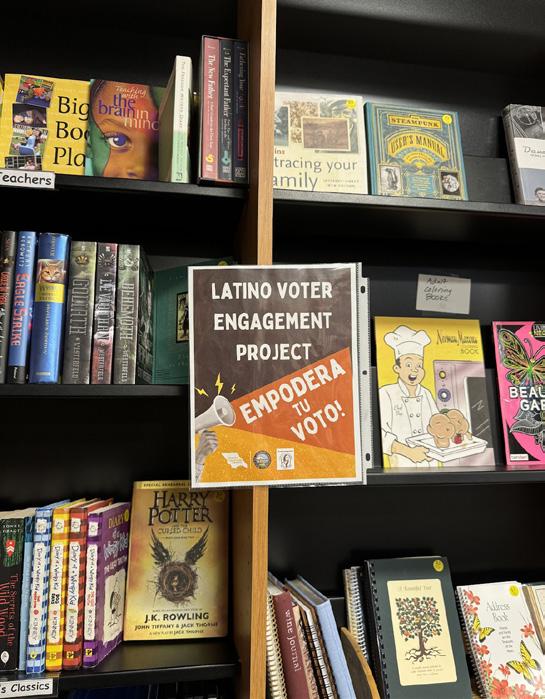
Póster para los talleres publicado en la Biblioteca Cambria.
miembros de la comunidad Latinx se sientan empoderados, continúen utilizando los recursos disponibles y participen en las elecciones.
“Mi mensaje para la comunidad hispanohablante es simple: tu voto importa,” dijo Zamora. “Tu voz tiene poder, y puede moldear el futuro de tu comunidad.”

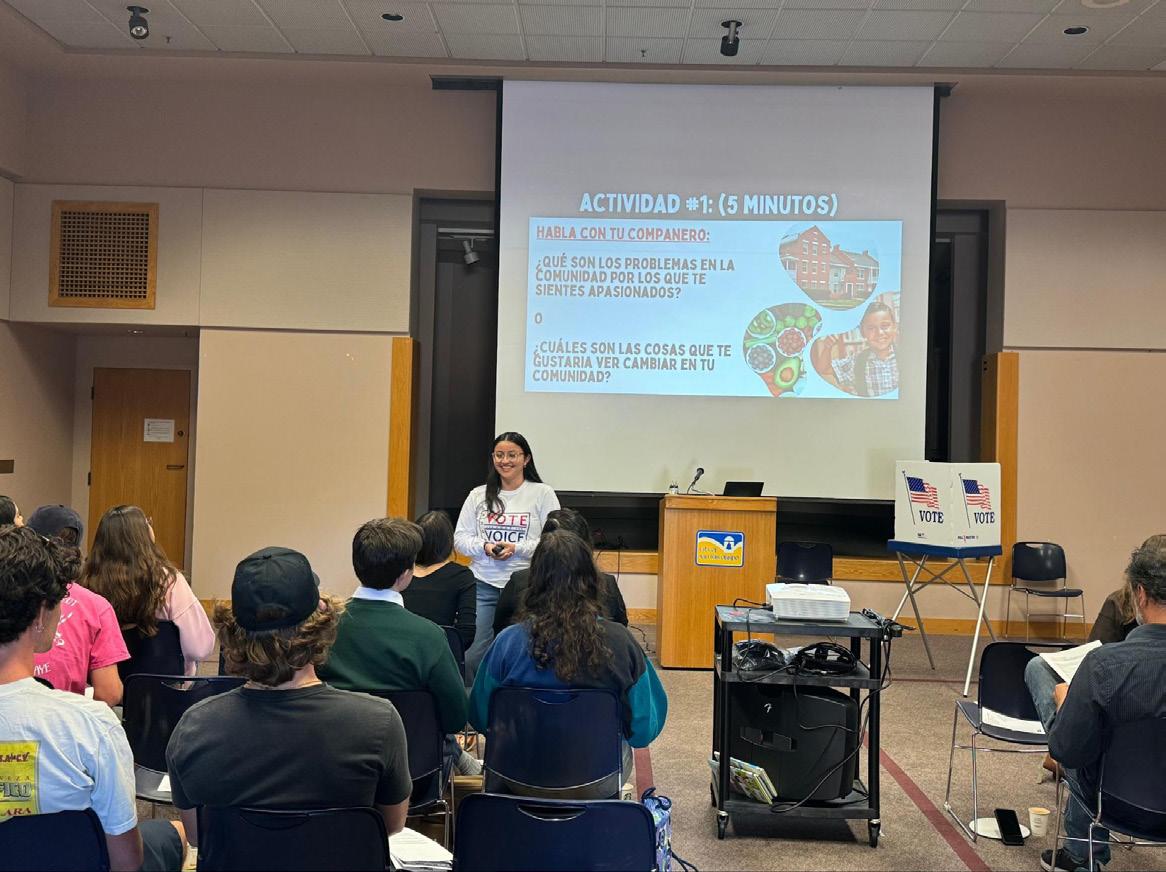
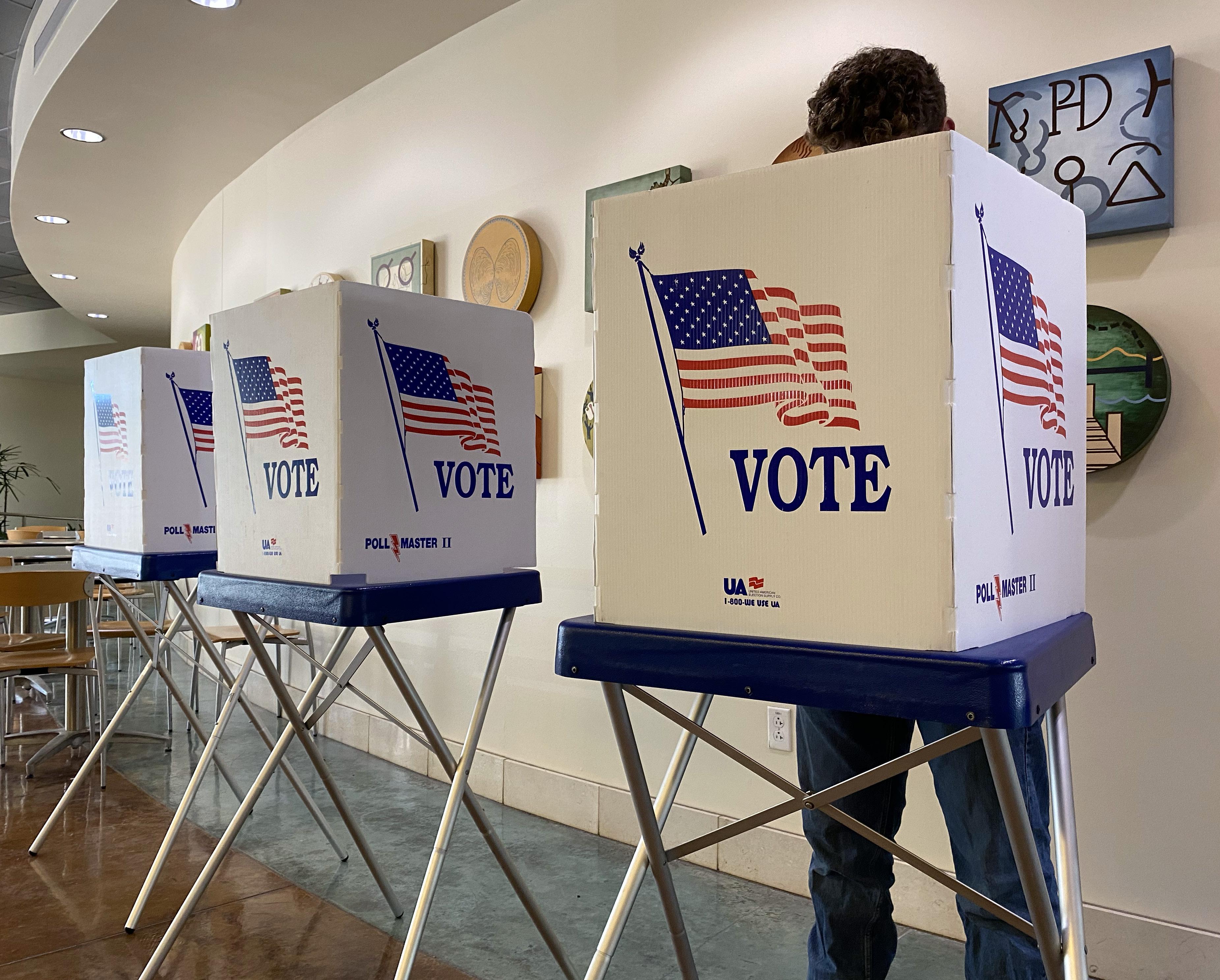
BY JOHN MACEDO
Like many in the country, political science senior Natalie Venable will cast her first presidential vote on Nov. 5. But her civic duties won’t stop there. She’ll be a poll worker that day too, performing various duties at an assigned polling location to ensure Election Day runs smoothly and all votes are counted fairly.
“I feel passionately that everyone should have access to voting, so I wanted to help facilitate that,” Venable said. “I’m really excited to be processing voters and just getting to participate in the democratic process.”
On Election Day, workers arrive at 6 a.m. to set up and test machines at polling locations throughout the county. After polls close at 8 p.m., they will count ballots, pack up, and deliver everything to a central collection point for counting.
Cal Poly students make up one of the biggest groups of poll workers in the county, said Erin Clausen, Public Information Officer for the San Luis Obispo County Clerk-Recorder. Other major groups that serve as poll workers include high schoolers or people in retirement.
The experience is about patriotism, community and personal fulfillment said environmental studies senior Mel Kuzo, who was a poll worker in 2020.
“I loved the discussions I had with the people I worked with, as well as helping those who came to vote.
Being a poll worker makes me feel very virtuous,” Kuzo said.
“I am working at the polls this year for class credit, but also of my own volition,” Kuzo said. Political science classes such as Environmental Design (EDES 406) offer extra credit
for signing up as a poll worker through the Clerk-Recorder’s Office.
San Luis Obispo County poll workers can attend an optional threehour training prior to Election Day, which covers the handbook and procedures for greeting, check-ins and issuing ballots without bias.
Poll workers receive an extra $20 for attending the training, which is highly encouraged due to the significant duties involved and the strong opinions often expressed in long polling lines, Clausen explained.
To become a precinct worker in San Luis Obispo County, a person must be a registered voter in California or a legal permanent resident of the U.S. and at least 16 years of age. You also must complete an application through the San Luis Obispo County Clerk-Recorder’s website
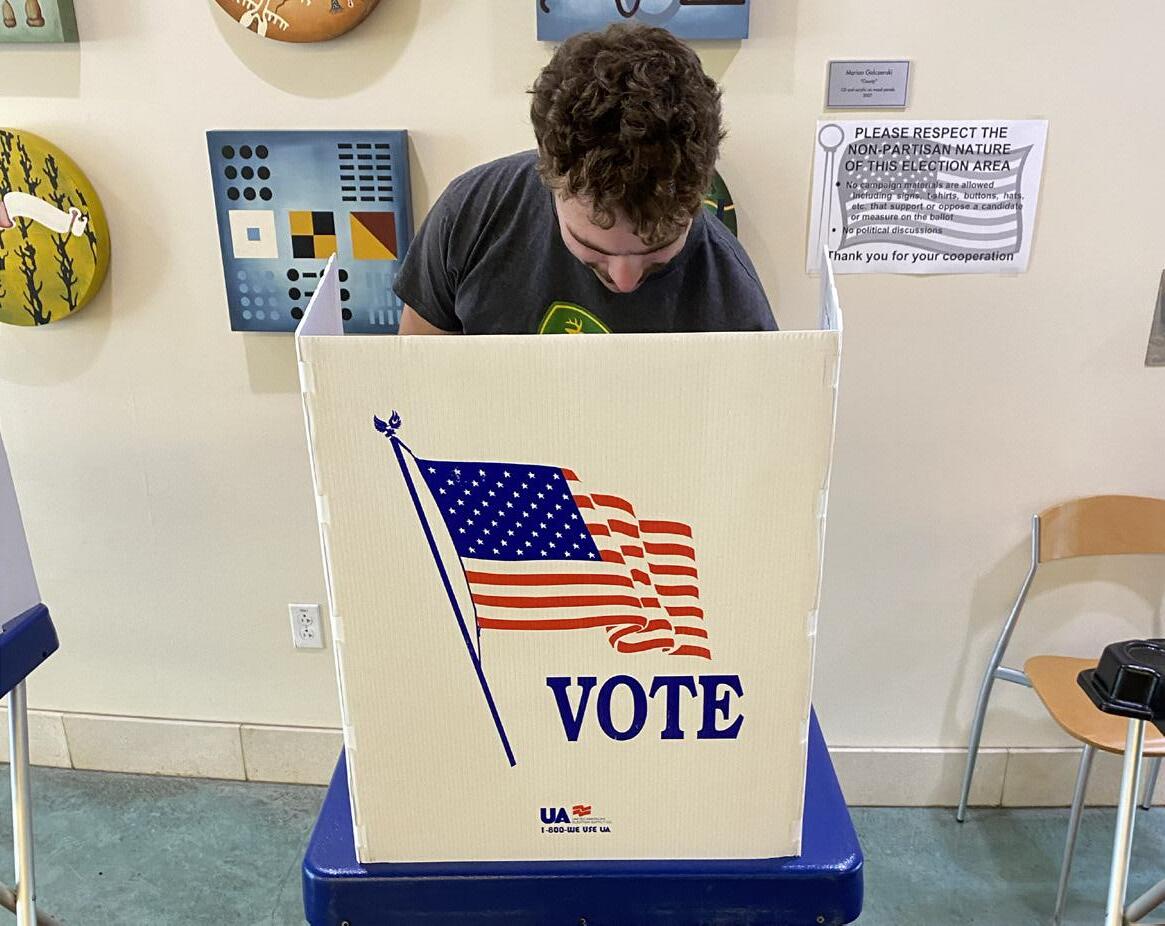
Mail-in ballots have been sent out and can either be mailed back using the return envelope included, or dropped-off in person to one of the following locations in San Luis Obispo by Nov. 5.
SAN LUIS OBISPO
VOTE-BY-MAIL BALLOT DROP BOX LOCATIONS:
1. Cal poly state university
• Julian A. McPhee University Union 2nd Floor. 1 Grand Avenue. 24 hours/7 days a week
2. San Luis Obispo County ClerkRecorder’s Office
• 1055 Monterey St. 24 hours / 7 days a week
3. Department of Social Services
• 3433 S Higuera St. M-F: 8:00am - 5:00pm.
SAN LUIS OBISPO POLLING PLACE LOCATIONS:
1. Performing Arts Center SLO
• 1 Grand Avenue
2. Ludwick Community Center
• 864 Santa Rose St
3. Grace Central Coast
• 1350 Osos St
4. San Luis Obispo Grange Hall
• 2880 Broad St
5. Chumash Village
• 3057 Higuera St
6. The Octagon Barn Center
• 4400 Octagon Way
7. ACI Jet
• 4751 Aviadores Way

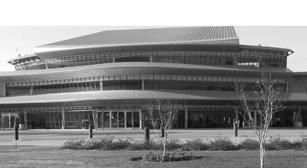

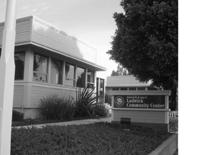



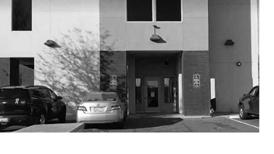

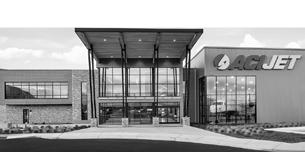
BY KRITHI SANKAR
With Election Day fast approaching, San Luis Obispo County acquired a new Dominion High Pro ballot scanner to expedite the counting of local election results, according to Erin Clausen, San Luis Obispo County Clerk-Recorder Public Information Specialist.
Clausen said the scanner triples the speed of existing machines. The ballot-counting process is overseen by the county clerk-recorder and her office’s elections employees.
The county signed a five-year contract with Dominion Voting Systems on July 8 to use their scanners and other voting technology. When deciding on the contract, County Supervisor Debbie Arnold and sixteen community members raised concerns about the machines’ integrity.
On a national scale, Dominion sued Fox News for perpetuating unsubstantiated claims of election fraud in 2023, and Fox News settled the lawsuit for over $787 million.
The United States Elections Assistance Commission and the
California Office of Voting Systems Technology Assessment extensively and independently verified Dominion’s voting technology. Clausen said that with scrutinized access to the physical ballot-counting machines and no internet access, any chances of altering election results are highly limited.
Here is a breakdown of the county’s ballot-counting process:
LAYERS OF TESTING FOR ACCURACY
When a ballot is initially received, volunteers will cross-reference the signature on the ballot with the one documented on voter records. If one member of a household accidentally signs another’s ballot, officials can reference their voter and driver’s license records to confirm the validity of the ballots, according to Clausen.
Prior to ballot counting, the machines go through logic and accuracy testing, according to state elections code. The county is given a
variety of test decks, which are stacks of ballots with pre-determined results, to test machine accuracy.
of four. Elections officials take shifts inputting received vote-by-mail ballots into vote-counting machines.
“The county employs two other methods to verify the legitimacy of the ballots they receive,” Clausen said.
We truly appreciate when someone cares enough to ask us a question. We’re nonpartisan. We serve voters of all stripes and we are happy to talk with anyone.
ERIN CLAUSEN
San Luis Obispo County ClerkRecorder Public Information Specialist
The existing machines can count ballots in individual sets of 50, while the new Dominion High Pro machine holds 200 ballots in batches
The first is adjudication—a process used when bubbles on a ballot are marked unclearly. The ballot is analyzed by three different election employees to correctly determine which answer was meant to be selected.
The final step is the manual tally count. After final ballots are counted, the county Clerk-Recorder randomly aggregates 1% of ballots cast. Elections officials hand-count those ballots and compare them with machine-counted results to ensure consistency.
Other than voting, any member of the public can actively participate in the election process by watching it happen in real-time.
Community members can sign up to be poll watchers, a voluntary program to observe polling locations as residents cast their votes, Clausen said.
Poll watchers must fill out paperwork and complete in-person training before Election Day. They are also required to stand over 100 feet from a polling location during voting hours, according to the county’s poll watching guide.
The election observers program is for those who want to be in the recorder’s office as employees verify and count results. Observers must sign their name and reason for their visit and wear a visitor badge, Clausen said.
For voters who are unsure about the election process, Clausen recommends speaking with an election employee to understand the mechanics more thoroughly.
“We truly appreciate when someone cares enough to ask us a question,” Clausen said. “We’re nonpartisan. We serve voters of all stripes and we are happy to talk with anyone.”
BY LAUREN QUIJANO
Every election year, dozens of ballots are mailed to the San Luis Obispo County Elections Office.
Once ballots arrive, they’re put through a scanner that captures the voters’ signature.
The ballots then go through a signature verification system where trained staff determine if the signature matches the voter on file. This is done by looking at signatures from past elections or driver’s licenses.
Joanne Johnson has worked in the elections office for two years, and today she’s verifying signatures.
“A lot of people sign with squiggly lines, and it’s interesting that squiggly lines look the same over time,” Johnson said. “So if it’s a squiggly line we check it because we have signatures from prior elections and if it looks the same it’s good to go.”
Once the signatures are verified the ballots go to the slicer. This machine opens the ballots so staff members can manually remove and inspect them to ensure the ballots aren’t damaged.
“We remove the ballot from the envelope, and then we have our election staff that inspects the ballots to
make sure that there is no red pen, no damage, nor writing all over it, and that the voters just followed the instructions and bubbled [their vote] in.” said County Clerk-Recorder, Elaina Cano.
If a ballot is damaged, a team of staff members hold the original ballot and call out every vote marked so another member can copy the same choices on a new ballot. Finally, another member inspects the original ballot and the new ballot to ensure they match.
Ballots are sorted into batches of 200 for tabulation, which is also known as the countivng machine. This machine can hold more ballots and count them quicker.
If the machine rejects any ballots, they are set aside and a ballot that has been remade is added to keep the batch at 200.
If the machine detects any irregular ballots they are displayed on screens, and a team made up of two election employees agrees on the voters’ intent.
So if it’s a squiggly line we check it because we have signatures from prior elections and if it looks the same it’s good to go.
JOANNE JOHNSON
Once the ballots are counted, they are boxed and sealed with a tamper evident seal for storage.
“So all of our election supplies, ballots, envelopes, and anything that has to do with this election gets stored in a secured area for 22 months, and then after 22 months, we have a shredding company come out and shreds all the documents,” Cano said. “Then it’s right in time for the new election.”
The last day to mail in a voter ballot is on Nov. 5. The county elections office must receive the ballot no later than seven days after the election to be counted.
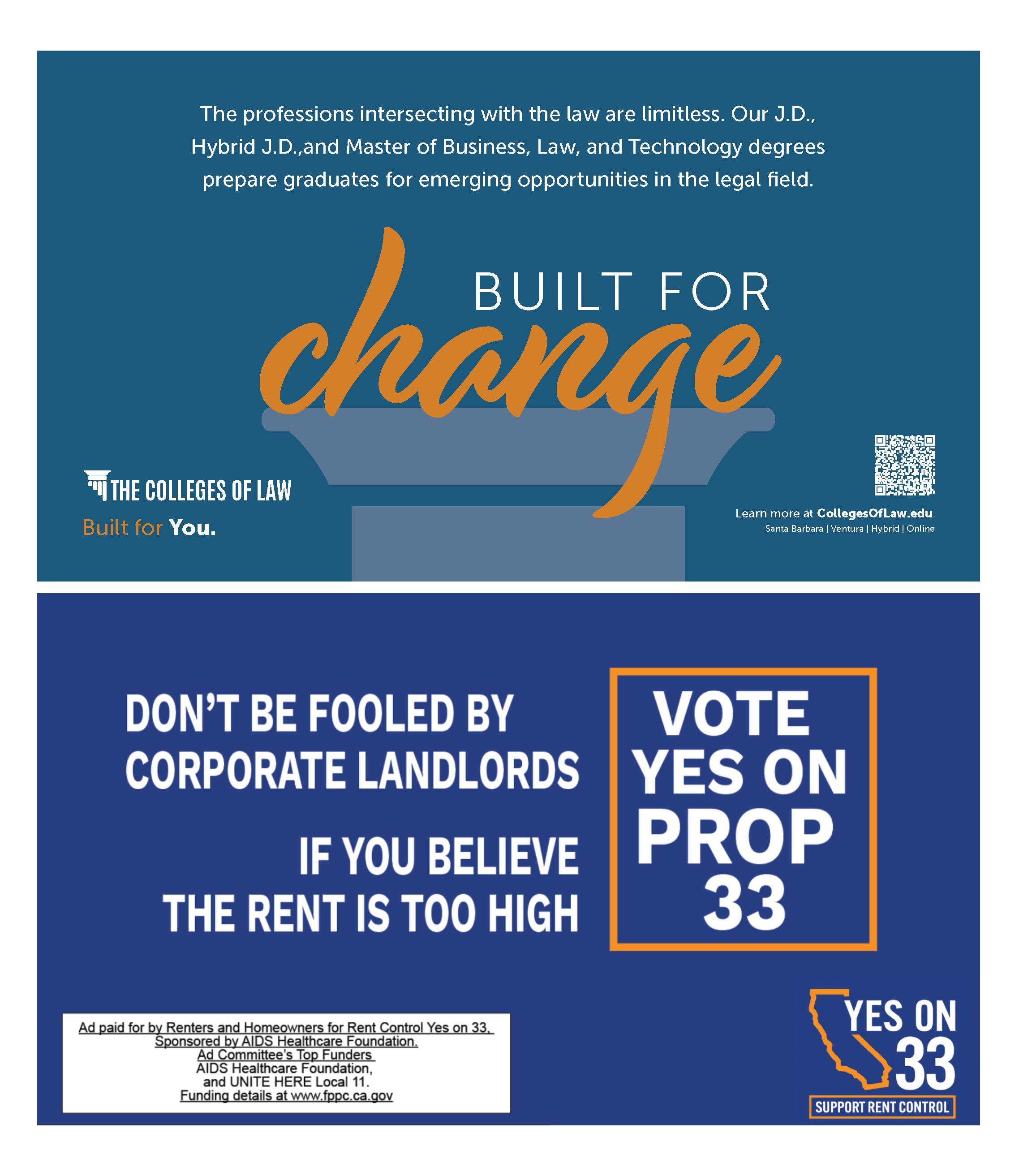

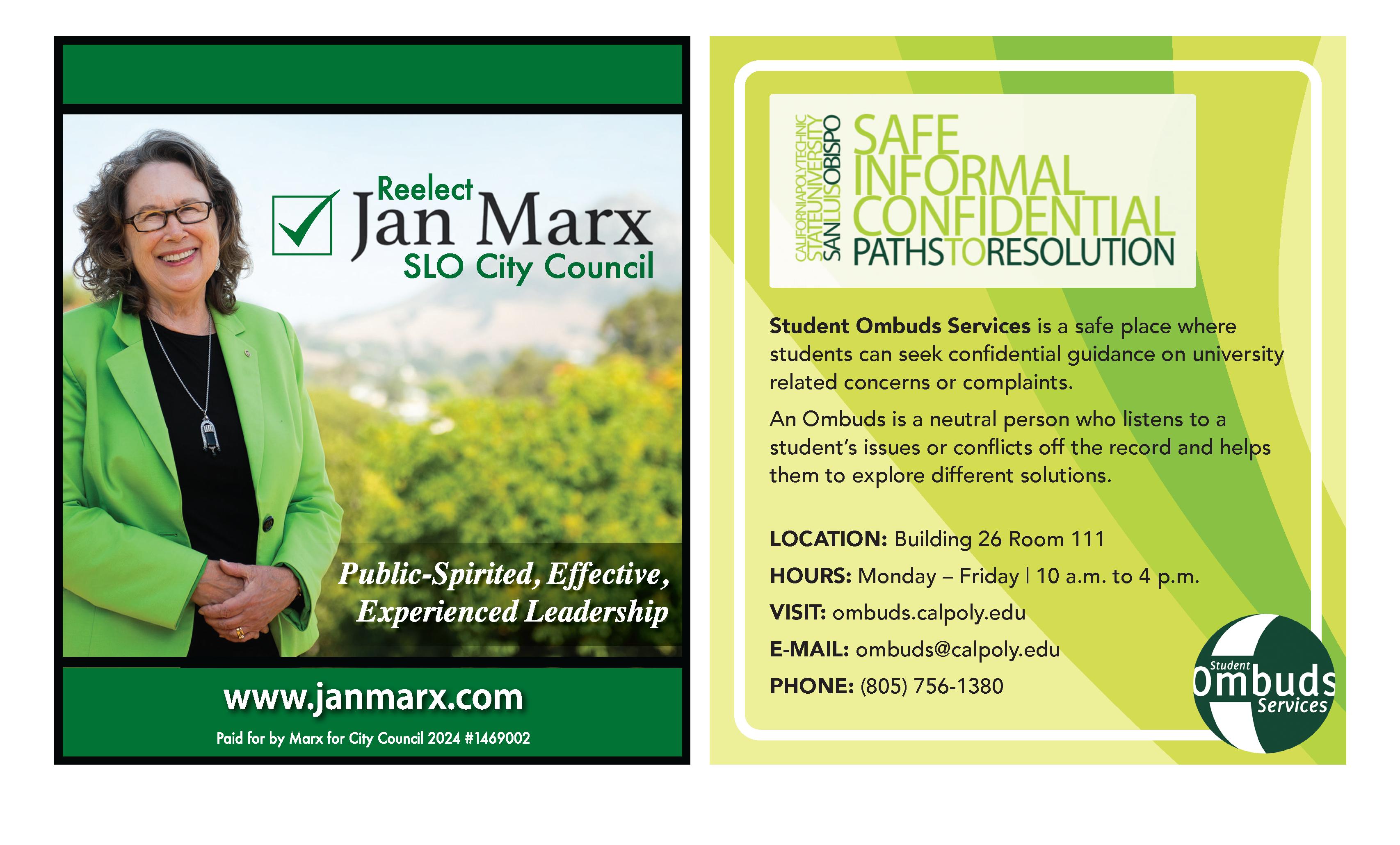
BY NICK FORSELLES
Mustang News sat down with each of the candidates running for mayor and city council to get their perspectives on local issues, their visions for the community and what they hope to achieve if elected. Readers can watch the full interviews on our YouTube channel.


The San Luis Obispo City Council is the legislative body responsible for making decisions on local policies, budgets and community priorities, according to the city’s website. The mayor works alongside four other City Council members to set legislative priorities, adopt
Donald Hendrick is a longtime San Luis Obispo resident and Cal Poly industrial technology alumnus who graduated in 1969. He has run for the mayoral office every election cycle since 2006 and has served on the board of local nonprofits Grass Roots II Inc and Economic Opportunity Commission.
Hedrick’s motivation to run for mayor stems from a desire to preserve the historic character of San Luis Obispo and resist what he believes is the undue influence of special interests.
“We need to be very careful; our town is being bought up by outside interests,” Hendrick told Mustang News. “It’s not being developed for the benefit of the people who live here.”
Hendrick’s campaign focuses on maintaining the community’s identity by limiting high-density development and preventing further changes to parking and traffic patterns that he
Erica A. Stewart is a Cal Poly home economics alumna and the incumbent mayor of San Luis Obispo, having served since 2021. She is currently a communication studies lecturer within Cal Poly’s College of Liberal Arts. With a background in community engagement, Stewart said she prioritizes housing and homelessness.
“Housing and homelessness of course is an issue that I think will stay a top priority for the city,” Stewart told Mustang News. “We have quite a bit of affordable housing coming open in the next five years, about 500 units.”
Stewart is also focused on environmental sustainability, working toward the city’s goal of carbon neutrality by 2035. She said that this would include expanding public transportation options and increasing the number of electric vehicle charging stations in the city.
“We’re helping create more charging stations for electric cars [and] making sure that people have other ways to get around this community, whether it’s by walking, riding a bike or a scooter,” Stewart said.
policies, approve budgets and oversee the city’s direction.
This year’s mayoral race is between Erica A. Stewart, the incumbent, and Donald Hedrick, who will be running for the sixth time.
feels negatively impact residents. He said he is particularly opposed to recent projects that separate bike lanes from car traffic, believing that they complicate traffic flow.
Hendrick expressed concern about the pace and direction of development in San Luis Obispo, and urged residents to stay informed and engaged with the ongoing changes.
“We need to have an eye on what’s going on—not just what you see, but the impact that changes are being forced on our town,” Hendrick said.
HENDRICK’S MAIN OBJECTIVES:
• Preserve San Luis Obispo’s historical character and oppose rapid development.
• Limit special interest influences in city policies.
• Oppose high-rise construction and new parking changes.
In her role as mayor, Stewart established Cal Poly’s Office of Diversity, Equity and Inclusion in 2023 to engage with various community members and address issues of inclusivity. She believes that open communication is key to understanding and addressing the needs of the community.
To better engage with Cal Poly students, Stewart has made efforts to connect directly with campus clubs and organizations ahead of the November election.
“I started off [the] beginning of September meeting with the student leadership,” Stewart said. “[I’m focused on] just understanding what the student government has planned.”
STEWART’S MAIN OBJECTIVES:
• Increase affordable housing for middle-in come residents and graduates.
• Support diversity, equity and inclusion in local businesses and nonprofits.
• Reach citywide carbon neutrality by 2035 with sustainable energy and transportation.
• Expand and improve public transportation services.



According to the City of San Luis Obispo’s website, the San Luis Obispo City Council is the legislative body responsible for making decisions on local policies, budgets and community priorities. The council is made up of four members and the mayor, who each have voting power on city matters.
John Drake is a Cal Poly political science alumnus currently serving as a project manager and coordinator for the San Luis Obispo County Behavioral Health Department. His passion for community improvement drives his campaign for City Council, with a strong focus on revitalizing downtown and supporting local businesses.
“A thriving downtown is so vital to college life,” Drake told Mustang News. “It’s the place where [students] make memories and interact with the society around them.”
Drake’s policies also emphasize sustainability, particularly the importance of energy infrastructure.
“We can push for greener energy, but if we
Mike Boswell is a Cal Poly City and Regional Planning professor and serves as the department’s chair, with 26 years of experience living and working in San Luis Obispo. Boswell’s research focuses on climate change and helping cities reduce their carbon footprint. He views his candidacy as a way to give back to the place that has been meaningful to him and his family.
“The community has given us so much,” Boswell told Mustang News. “I saw this as an opportunity to give back to the community of San Luis Obispo.”
Boswell’s campaign is centered on a few key priorities: protecting open spaces, improving traffic safety, addressing housing and homelessness, and promoting climate action. He wants to continue building on the city’s Green Belt Program to preserve natural areas, ensure safer streets for cyclists and pedestrians, and address housing challenges for residents facing hardship.
One of Boswell’s main goals is to reduce
JAN MARX
Jan Marx, a longtime public servant in San Luis Obispo, is running for re-election to the city council. With 16 years of council experience and six years as mayor from 2010-2016, Marx is focused on continuing her efforts to preserve the city’s open spaces and support renters.
“Before I was ever on city council, I spearheaded the whole campaign to get Bishop’s Peak to be open to the public [in the 1990s],” Marx told Mustang News. “That [campaign] was the kickoff, and since then I’ve been working to complete the [Greenway].”
Having taught at Cal Poly as a lecturer and lived in student neighborhoods for years, Marx said she has a deep understanding of student concerns. She advocates for better relations between students and permanent residents, working to create neighborhoods where everyone feels respected.
“I’ve worked hard to try to improve relationships between the students and their neighbors,” Marx said. “People have to really talk
This year’s City Council race includes Jan Marx, seeking re-election after 16 years on the council, alongside first-time candidates John Drake, a Cal Poly alumnus, and Mike Boswell, a city and regional planning professor.
do not have the energy to back up those ambitions, then we’re dead in the water,” Drake said, highlighting his commitment to achieving the city’s 2035 carbon neutrality goal.
Additionally, Drake advocates for community engagement.
“It’s time that San Luis Obispo not only continue progress but also create change and really pave the path forward,” Drake said.
DRAKE’S MAIN OBJECTIVES:
• Revitalize downtown businesses and elevate the downtown experience
• Provide more resources and support for the unhoused
• Promote green energy projects for carbon neutrality.
traffic-related fatalities by advancing the city’s Vision Zero program, which aims to eliminate traffic deaths and severe injuries through safer road designs and policies.
“[On] Foothill [Boulevard] and other places, that’s where we’ve seen some of the bicycle deaths in the community,” Boswell said. “I want that number to be zero.”
Boswell previously served on the San Luis Obispo Planning Commission and the Local Revenue Measure Advisory Committee, handling land use, transportation and budgetary issues. With over 30 years of experience as a city and regional planner, Boswell said he plans to apply his expertise to city policymaking.
BOSWELL’S MAIN OBJECTIVES:
• Protect open spaces by completing the Green Belt Program
• Improve traffic safety for cyclists and pedestrians
• Address housing shortages and homelessness with stronger city programs
• Implement sustainable practices into city
with each other and figure out how to be good neighbors, both the permanent residents and the students.”
Marx said she is also focused on the importance of tenant protections, particularly for students and renters facing San Luis Obispo’s high housing costs. She aims to explore more tools the city can use to improve housing quality and affordability, with a focus on renter rights.
On the topic of climate action, Marx aims to advance the city’s climate resilience efforts, with priorities including water security and emergency preparedness for earthquakes and floods.
MARX’S MAIN OBJECTIVES:
• Strengthen tenant protections to combat high rent and poor housing
• Improve relationships between students and neighbors
• Enhance safety and disaster readiness
• Provide solutions to homelessness with better use of city resources.
BY JOHN WASHINGTON
Over 60% of the population rent their homes in San Luis Obispo, according to the city. A large chunk of that rental population is college students living off-campus, who often have to reach out of their price range to secure housing.
Renters have been protected from annual price hikes exceeding 10% of their rate since California implemented the Tenant Protection Act in 2020, but this was only one step of the process. This year’s Proposition 33 aims to grant local governments expanded rights in adopting rent-control measures.
In doing so, Proposition 33 would repeal the Costa-Hawkins Rental Housing Act of 1995. Costa-Hawkins limited the types of housing that local governments could subject to rent control. Under that act, single-family houses, apartments built after 1995 and condominiums are off-limits for cities imposing rent control. The statewide rent-control measure built into the Tenant Protection Act only protects against the most egregious markups, which is why cities like San Francisco, Los Angeles and San Jose instituted their own rent control. If this proposition passes, those cities will be allowed to expand their legislation to cover all rental housing.
In addition to the power to control increased rates, local governments would also have the ability to control rent levels of first-time tenants. Not only would this legislation empower renters hoping to remain in their current homes, but those looking to move into a new home could be ensured of their own reasonable price points.
Voting in favor of this legislation might seem like a no-brainer for students looking out for their rights as renters. The city of San Luis Obispo would be free to pass further tenantfriendly legislation and allow you to move into a single-family home with your friends next year without worrying about being priced out the following year. The decision will be as simple as that for some voters. Because the language is not hyper-specific, it is easy to get confused about what the proposition can and cannot do.
Remember, this proposition doesn’t just impact college students. California’s 17 million renters pay more on average to rent their home than residents of every other state outside of Hawaii (over $1,900, according to doxo’s 2023 Household Bill Pay Report). More than half of those 17 million are considered rentburdened, spending more than 30% of income on rent.
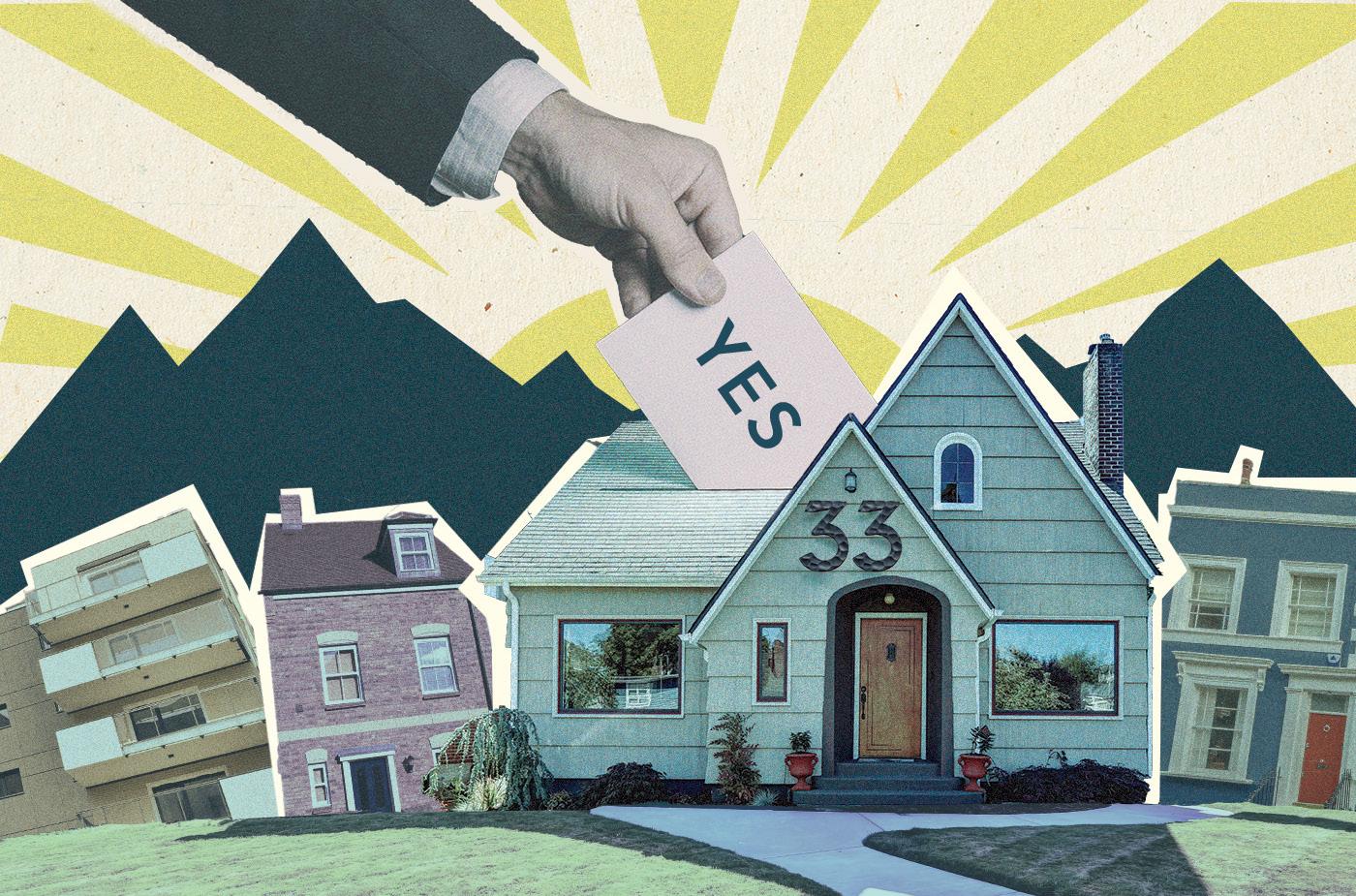
We know that homelessness is a huge statewide and local problem. Almost 186,000 people across California were homeless on a recorded night in January, CalMatters said. San Luis Obispo County’s contribution to that report identified 1,171 individuals who fit that criteria in their jurisdiction.
While the county’s findings improved on their 2022 numbers, there is still work to do.
Almost half of the surveyed individuals from the aforementioned county report were experiencing their first bout of homelessness, meaning they were likely recently priced out of renting. If cities can legislate this control on all types of properties, they can improve lives rapidly.
Though the housing crisis is statewide, not every county – or city, even – has the same level of issues. It makes sense for this responsibility to be handed down to each jurisdiction. For those who confidently say “rent control doesn’t work,” much of the reason it has failed
to excel in California is because of limits set by the Costa-Hawkins Act. Costa-Hawkins has been widely criticized for years, primarily for sticking to 1995 as the cutoff year for when properties qualify for rent control. As a result, it becomes more defunct with each passing year and should, if nothing else, be amended by way of update.
Another central argument against Proposition 33 warns of stricter rent control driving developers out of California cities that need more units built. Though a reasonable concern amidst the aforementioned housing crisis, this legislation promises none of that. Cities will be able to make their own well-researched and democratic decisions based on their needs. It is a jump to assume Proposition 33 does anything more than opening the door for certain cities whose renters are struggling. It is safe to assume most cities in California will continue to operate only under the state’s broader rent control measures.
The claims of landlord organizations insisting this proposition will severely hurt business are also unfounded. Landlords have a right in California to a “fair return” on their property rentals, and this protection will continue to ensure they get more than they deserve for graciously allowing people to live on their land.
To students in an unfriendly rental market, I welcome you to think through this vote in the plainest of terms: looking out for your own tenant rights. In case you needed reminding, this is California we are talking about, not Iowa. Nearly one of every three renters here spends more than half of their income on rent. This legislation allows you to join up with millions of other citizens worried about keeping up with their rent every month. Of course, I suggest you continue to research the proposition. That being said, I am voting yes on Proposition 33, and I encourage you to do the same.
BY ADITI SRIRAM
Here’s a quick exercise: Think about your friends and try to guess who each of them is voting for, or who they would vote for.
You probably found it pretty easy, right?
That’s because we tend to surround ourselves with people who share similar views, whether we realize it or not. We assume everyone thinks the same way we do because our social circles, both in real life and online, often reinforce our own beliefs. But in reality, the larger population is much more diverse.
As the 2024 U.S. elections approach, the term “voter bias” has become increasingly relevant. But what does voter bias really mean?
Voter bias refers to the behavior of voters influenced by preconceived notions and unconscious biases. It captures the tendency of individuals to favor certain candidates based on personal beliefs, experiences or affiliations rather than objectively assessing
In every election, it is essential to vote informed, yet it is also natural for personal values to shape how we view candidates. It all comes down to personal preferences, some may vote based on the candidate themselves while others may vote based on their policies.
Rejecting a candidate based on their demeanor might be less about being uninformed and more about personal priorities in leadership, which is completely reasonable.
However, when voters fail to vote smart by relying solely on emotions or superficial judgments, they risk electing officials whose policies may not truly align with their long-term needs or the greater good. Voting thoughtfully is crucial to ensuring leaders are both capable and aligned with the public’s best interest.
Here at Cal Poly, people from different parts of the state, country, and even the world come together as peers, classmates, and co-workers. This diverse environment offers
exposure to new perspectives and contributes to open-mindedness, one of the great aspects of the college experience.
However, while embracing new ideas, it is crucial to do your own research and avoid accepting everything at face value.
In today’s world, much of our information regarding campaigns, platforms and political decisions comes from media outlets, but the quality of this information varies widely. Social media plays a significant role in politics and is a source of voter bias.
The question arises: Is the information provided effective and unbiased enough to help voters make informed decisions?
Voting is crucial, and it should be based on careful research and a well-rounded understanding of the current social, economic, and political climate—free from external influence.
Unfortunately, political debates are often sensationalized on social media, turning them
into entertainment or comedic skits, which distorts the information voters receive. This fosters a skewed, biased perspective rather than offering factual, balanced insights. While the media can enhance access to information, it also has the potential to mislead if not approached critically.
Overcoming voter bias can be especially challenging for younger voters. They grew up in a world dominated by technology, where information and opinions constantly flow through online platforms. This environment can make it harder for younger voters to assess information or consider opposing viewpoints critically.
This can feel overwhelming—what can you rely on if you can’t trust everything online? Fortunately, there are steps you can take to ensure you are well-informed and protected from bias.
To start, ensure the article uses neutral language. Verify that the source is not heavily one-sided, satirical or directly affiliated with a political party aiming to sway readers’ views. Finally, check the credibility of the author and sources.
For many students, this is their first time participating in an election. Every vote matters, so take the time to research, stand by your beliefs, and make an informed choice. If we don’t take this responsibility seriously, we risk letting others shape the future of the nation in ways that may be irreparable.

BY ARCHANA PISUPATI
Waiting for results on election night can sometimes be nerve-wracking and overwhelming but also exciting. That’s why Mustang News prepared an all-inclusive guide to hosting an election night watch party for an exciting and adventurous night.
Lucky for you, election night has a concrete time and date. Stock up on snacks from Trader Joe’s or the SLO Farmers Market. Add in some red and blue streamers and decorations to set an election theme. Bring in some cushions or blankets to stay comfy throughout the night.


Set up a projector or TV to display live election results. Want to focus on local elections? Visit mustangnews. net to receive live updates on election coverage. Tune in from 8 to 9 p.m. for MMG’s live election show, also broadcasting on 91.3 KCPR.
Keep your guests engaged with activities and games like election bingo or even trivia about San Luis Obispo’s election history. It can be a fun night while staying informed, so bring something for everyone, political buffs or those coming for the company!

Get your crew excited with an eye-catching invite! Let them know when the watch party starts and what to bring.
Now, it’s time to kick back and let the night unfold! Watch the results, from the big races to our very own local ones and soak in the night with friends. Don’t forget to snap a few photos!

Regardless of the election results this year, indulge in the satisfaction of casting your ballots and participating in nationwide elections. If you need counseling or support because of this event, consider connecting with your social circles and communities such as family, classmates or campus offices. You can also find campus resources at these places: Counseling Services (Building 27): Available by phone at 805-756-2511. Same day appointments are available for
urgent situations. If you need immediate assistance, call the crisis line at 805-756-2511. Dean of Students Office: Support services are also available at 805-756-0327 or email deanofstudents@calpoly. edu

31% of Cal Poly student voters will cast their ballot in San Luis Obispo, based on Mustang News survey results
BY JEREMY GARZA
Eliska Martinez serves on the county’s Gay and Lesbian Alliance, GALA, Pride and Diversity Center board of directors as the external governmental affairs chair. In her role, she monitors local legislation like local homelessness response and construction downtown.
This November, she’s among the 31% of the student voters planning to cast their ballots in San Luis Obispo’s elections, based on Mustang News survey results. She’s choosing to vote where she lives, even if only for a few years.
“Maybe you do go home for the summer or you’re only here for school, but you do live here,” the mechanical engineering junior said, referring to other students. “Your choice and your actions affect the community as well. Even if you’re just planning to be here for three or four years, you’re still here. Everything that happens in the city still affects you.”
She also works at a boutique in downtown San Luis Obispo. With rising parking fees, climbing rent prices and business closures, she’s ready to voice her opinion on policies in San Luis Obispo. Mustang News randomly surveyed students about their participation in the upcoming elections. Of the
respondents, 86% intend to vote.
One of SLO County Democratic Party’s major student outreach objectives is getting the demographic to register to vote in the county’s local elections, according to Barry Price, Secretary of the SLO County Democratic Party Central Committee. He said many students do not realize the impact of San Luis Obispo local elections.
the cost of rent in this community, these are on the ballot in this county.”
Randall Jordan, Chairman of the Republican Party of SLO County, believes students, as “temporary residents,” should vote based on their home community or state instead of changing their address to vote in San Luis Obispo.
How public safety dollars are spent are on the ballot.
BARRY PRICE Secretary of the SLO County Democratic Party Central Committee
“We really believe that to be politically engaged you should be voting where you live,” Price said. “If you want to affect housing availability,

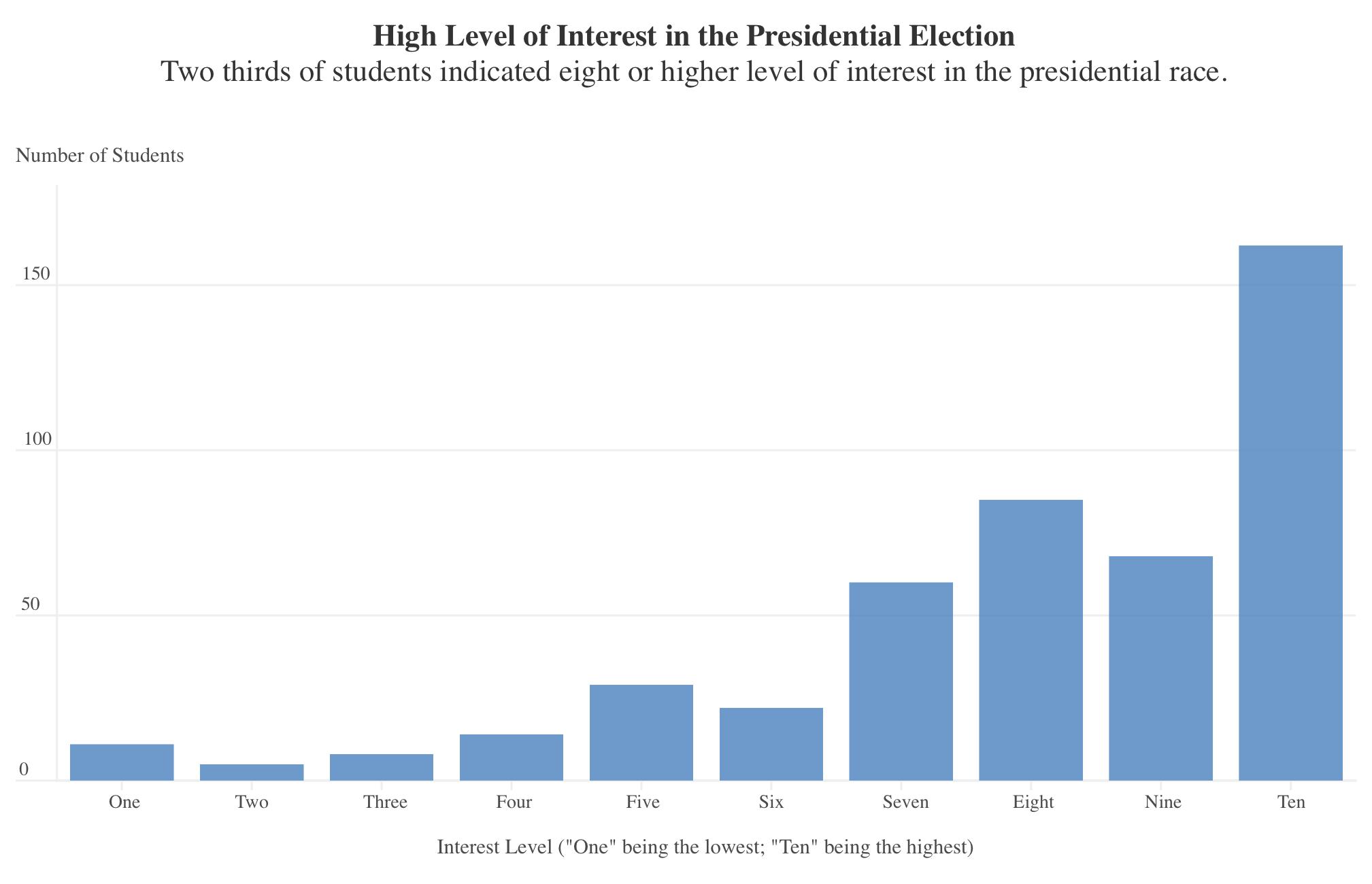
“I think that their roots are where they come from and most students will go back to that area after college,” Jordan said. “It would be more beneficial for them to vote in their local elections where they came from.”
Biochemistry freshman Bryce McCarthy is excited to vote for the first time this year and will be casting his ballot in his hometown, San Diego. He has been following the mayoral race for the past two years.
“I considered whether or not to change my address,” McCarthy said. “I chose not to because I’ve been here for a month. I think in order to make a more informed decision, I want to do more research.”
Over the next few years at Cal Poly, McCarthy thinks he will eventually start to vote in San Luis Obispo’s elections. Cal Poly students indicated a low interest level in this year’s SLO elections, based on the Mustang News election participation survey.
Whitney Cser will also be opting to vote outside of San Luis Obispo, in Roseville, CA. In contrast to McCarthy, Cser is focused on national elections and the power of the office of the president.
“With certain presidents, there has been an extreme high in inflation and that affects me,” the nutrition freshman said. “I really got interested in politics during COVID, when there
was so much controversy over masks and vaccines. It was so political. It should have been about health.”
Cal Poly students tend to be highly interested in the presidential election, based on the results of the survey. A third of respondents indicated the highest level of interest in the presidential election, compared to 4% of respondents who indicated the highest level of interest in the San Luis Obispo elections.
Cser is unlikely to vote in SLO elections while a student at Cal Poly, but is looking forward to voting for the first time.
“Being in California, I feel like I don’t have much of a say because
we’re such a blue state. Other than that, it is exciting to be able to vote,” Cser said.
Math junior Damian Gutierrez grew up in SLO County and believes every vote matters, even if California historically favors the Democratic party.
“I’ve always heard, ‘Oh, it’s California. So-and-so is going to win anyway,’” Gutierrez said. “That’s so frustrating to hear because it truly means so much to vote.”
Gutierrez acknowledges that many races likely will not be close in California, especially at the national level, but he believes using your right to vote defines living in America.
“I think it’s beautiful that we get to vote and pick who is going to have an impact on our life,” Gutierrez said. “If everyone thinks their vote doesn’t matter, then no one’s going to vote.”
This will be many students first time voting in a presidential election, like Quinn Pannell, a history junior. Many undergraduate students at Cal Poly were under the voting age during the 2020 election.
“I think that politics can be very polarizing,” Pannell said. “Voicing your own political opinion is important and a right that we all have as American citizens. It’s important to exercise your right and share what you believe.”


BY COLE PRESSLER & ALISHA NAZAR
Mustang News complied the most common questions about mail-in ballots. These responses aim to provide voter information, important deadlines and in-person voting options
This guide provides voter information, important deadlines and in-person voting options to ensure every vote is counted.
WILL I RECEIVE A VOTE-BY-MAIL PACKET?
All voters registered in San Luis Obispo County will receive a voteby-mail ballot at their address on file.
WHAT’S INCLUDED WITH MY BALLOT?
You will receive your ballot, a ballot-return envelope, a California voter information guide, a San Luis Obispo County voter information guide and instructions on how to vote in-person.
WHAT KIND OF VOTER INFORMATION GUIDE WILL I RECEIVE?
You will receive two booklets: one has information on statewide races, such as the Senate election and state ballot measures, and the other has information on county-specific races, like the San Luis Obispo Mayoral Election.
WHEN DO I HAVE TO MAIL MY BALLOT BACK FOR IT TO BE COUNTED?
Ballots that are mailed must be postmarked on or before Election Day and received by the San Luis Obispo Clerk-Recorder no later than 7 days after Election Day.
You can also return your ballot to an official ballot dropbox (including one at Cal Poly’s University Union) or polling location on Election Day instead of mailing it back.
WHAT IF I WANT TO VOTE IN PERSON INSTEAD?
If you received a mail-in ballot but want to vote in person, do not fill out your mail-in ballot and bring the blank ballot to a polling location on election day. A poll worker will help you trade it in for an in-person ballot.
WHERE IS MY IN-PERSON POLLING LOCATION?
The mail-in ballot you receive includes a paper slip detailing the closest polling location to your address.
HOW MANY PEOPLE USUALLY VOTE BY MAIL IN SAN LUIS OBISPO COUNTY?
According to the San Luis Obispo County Clerk Recorder, more than 90% of San Luis Obispo County voters voted by mail in the last three major elections since the pandemic—the 2021 gubernatorial recall election, the 2022 midterm election and this year’s Mar. 5 primary election.



